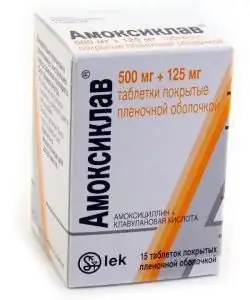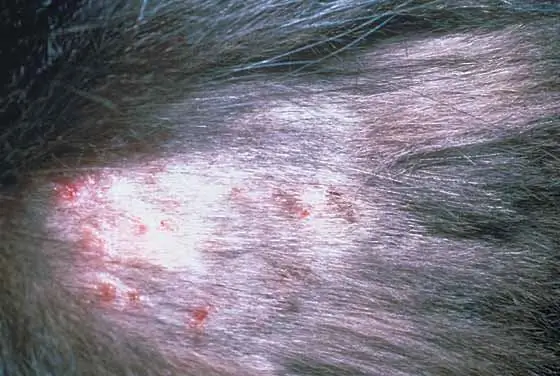2026 Author: Priscilla Miln | [email protected]. Last modified: 2025-01-22 17:55:27
The Yorkshire Terrier is a very popular breed. Dogs are well known for their small size and outgoing nature. Keeping pets in urban areas is quite easy, and this is one of the reasons why the choice falls on them so often.
However, the owners should not relax and forget about the he alth of their pet and the diseases of the Yorkshire Terrier: after all, the sooner the symptoms of the disease can be recognized, the easier it will be to defeat.

Retinal Dysplasia
Most often this is a congenital disease of dogs, in which the retina does not develop correctly during the growth of the animal and has folds, but sometimes dysplasia also occurs in puppies who have had viral diseases during development. If not treated promptly by a veterinarian, a Yorkshire Terrier disease such as retinal dysplasia can lead to blindness of the animal.
Symptoms of dysplasia are not always easy to notice, because there are not so many of them:
- enlarged pupils even in bright light;
- poor vision in dim light;
- puppies show symptoms before the age oftwo years.

A complete diagnosis should be carried out by a specialist with the help of an ophthalmological examination. The sooner the owners turn to him, the more the success of the upcoming treatment increases. It is highly undesirable to treat dysplasia on your own - this can lead to the most unfortunate consequences.
Legg-Calve-Perthes disease
This disease of the Yorkshire Terrier is also called aseptic necrosis of the femoral head. The reasons for its development have not yet been identified: it can be influenced by both heredity and excessive load on the hip joint. As the name suggests, Yorkshire Terrier breed disease can lead to aseptic-type necrosis and destruction of the femoral head due to reduced blood supply.

Symptoms of Perthes disease appear in puppies between the ages of six and twelve months, but they are not too difficult for caring owners to notice. This is:
- limping, which becomes more frequent over time;
- puppy's desire to save a paw and walk only on three;
- limited movement, for example, the dog may stop jumping.
A specialist can make this diagnosis after an examination and X-ray.
Treatment of Yorkshire terrier disease can be both therapeutic (but only in the early stages with not too severe damage), and surgical. In therapeutic treatment, the dog is prescribed drugs that will relieve inflammation, reducephysical activity for several months. It is also possible to use physiotherapy. Surgery usually occurs when the femoral head is fractured or destroyed. After surgery (resection hip arthroplasty), antibiotics and rehabilitation are prescribed.
Hypoglycemia
This Mini Yorkshire terrier disease associated with low blood sugar can have many different causes, from malnutrition to bacterial infections.

However, most often only puppies show symptoms at an early age (about three to four months old) due to the body's inability to control glucose levels at a young age.
Hypoglycemia and Yorkshire Terrier disease symptoms:
- loss of appetite;
- lethargy and weakness;
- trembling, convulsions;
in the most extreme cases it can lead to blindness, stupor and even coma.
If some of these signs appear in a puppy, you should immediately contact a veterinarian who can conduct all the necessary tests and make a diagnosis.
Hypoglycemia is treated by a specialist. Puppies need special feeding with a balanced diet every 3-4 hours and limited physical activity. Dogs in serious condition are usually hospitalized and kept in a hospital.
Tracheal collapse
Like other dwarf dogs, Yorkshire terriers are highly susceptible to this disease - there are genetic prerequisites for this, and the dog may also have an inherited defectcartilage. Due to the softening and flattening of the tracheal rings, the trachea loses its rigidity and takes on a C-shape instead of an O-shape.
Sometimes it happens that a disease has no symptoms until some factor is added that provokes its development. These factors can be:
- respiratory infections;
- obesity;
- increased heart size.
In such cases, the symptoms are clearly visible to the owners. This is usually:
- cough, persistent or vomiting;
- difficulty breathing through the mouth, shortness of breath;
- uneven breathing and increased heart rate.
A specialist can make a diagnosis based on X-ray or tracheobronchoscopy, which can determine the stage of the disease.
There are four in total:
- subsidence of the rings by 25% - the first stage;
- by 50% - second;
- by 75% - third;
- The fourth stage occurs when the upper wall touches the lower part of the trachea.
Treatment can be therapeutic only at the first stage - in this case, the factor that provoked the development of the disease is removed, for example, infections and obesity are treated. In addition, the presence of the dog in dusty air, next to cigarette smoke and other harmful gases and substances is limited.
From the second stage, surgical treatment is usually prescribed when the therapeutic one is useless. In this operation, a stent is installed in the dog, in simple words - a special tube, in a narrowing section of the trachea. It helps the pet to breathe.freely.

There is no cure for tracheal collapse, but owners can easily control it with the advice of veterinarians.
Portosystemic shunt
A shunt is a vessel that connects the portal vein and the systemic circulation, bypassing the liver. The danger is that without detoxification in the liver, harmful metabolic products enter the bloodstream and poison the body. This disease can be either congenital or acquired, and shunts are also intrahepatic and extrahepatic, but among Yorkshire terriers, the second type is more common.

In the case of a genetic predisposition, symptoms appear even in puppies up to one year old, but they are not easy to recognize.
Most often:
- excessively calm puppy character;
- slow growth;
- after eating - lethargy, weakness, depression;
- diarrhea, vomiting;
- blood in urine;
- in extreme cases, seizures, fever, blindness and even coma can occur.
Therapeutic treatment is aimed at normalizing the pet's metabolism, so various antibiotics, adsorbents and a low-protein diet are used. More often, surgical intervention is prescribed when a special ring is applied to the shunt, which gradually blocks the vessel.
This disease is very dangerous for a dog, so at the first symptoms, you should consult a veterinarian.
What diseases still exist in the Yorkshire Terrier?

In addition to diseases common to toy breeds, Yorkshire Terriers can also become infected with parasites against which they have no immunity, but there are many routes of infection.
Worms
Parasites in the Yorkshire Terrier can be both flukes and roundworms and tapeworms. Without an examination by a veterinarian and determination of a specific type of helminth, you should not give the dog any drugs, as this can bring not the most pleasant consequences for her, even death.
The symptoms of a worm infestation are fairly obvious:
- pet tries to scratch the floor or the area near the anus with his teeth;
- dramatic change in appetite - refusal to eat or, conversely, overeating without satiety;
- dull coat, generally depressed and inactive;
- mood changes, such as unexpected aggression;
- tense and distended abdomen;
- alternating diarrhea and constipation;
- large amount of mucus in feces;
- vomit.
If even a few signs of the described disease of Yorkies are found, how to treat the Yorkshire Terrier in the first place? You should go to the veterinarian without delay, as delay can lead to rupture of the rectum. The diagnosis is usually made after a stool test.
Conclusion
Only a specialist (veterinarian) can prescribe therapy for a beloved pet. You can also prevent the development of certain diseases in advance, but even in this case, you should first consult withvet.
Recommended:
Fish diseases: treatment and prevention. Diseases of aquarium fish

Fish diseases can be caused by a variety of factors, including: improper housing conditions (in the case of aquarium fish), infections transmitted from other fish, and also caused by single- or multi-celled parasites
Cat coughs: causes and consequences. Cat diseases: symptoms and treatment

How much joy our beloved pets bring us! Your affectionate fluffy (or smooth-haired) four-legged friend meets you from work, purrs with happiness that he has waited for his beloved owner, and in the evening tries to get on his knees and watch TV with you. Idyll… And suddenly you notice that the cat seems to be coughing. Is your pet sick?
Skin diseases in cats: a list of diseases, a description with a photo, causes and methods of treatment

The skin of pets is regularly exposed to various negative influences, they are bitten by fleas, ticks and various blood-sucking parasites. As a result of this, various skin diseases in cats, as well as problems with coat, can occur. It is very important to accurately diagnose and treat. This will prevent the occurrence of dangerous complications
York diseases: description of the most common diseases, treatment, prevention

Yorkie are not he althy enough. They get sick often. Many of the ailments are due to their small size. For example, it is traumatism of representatives. An animal usually gets injured due to human negligence. It is because of this that Yorkies are not suitable for all children. Also, these dogs often suffer from allergies and colds
Pigeons, their diseases and treatment. Pigeon diseases dangerous to humans

This article talks about the most common diseases of pigeons, many of which pose a serious danger to humans

